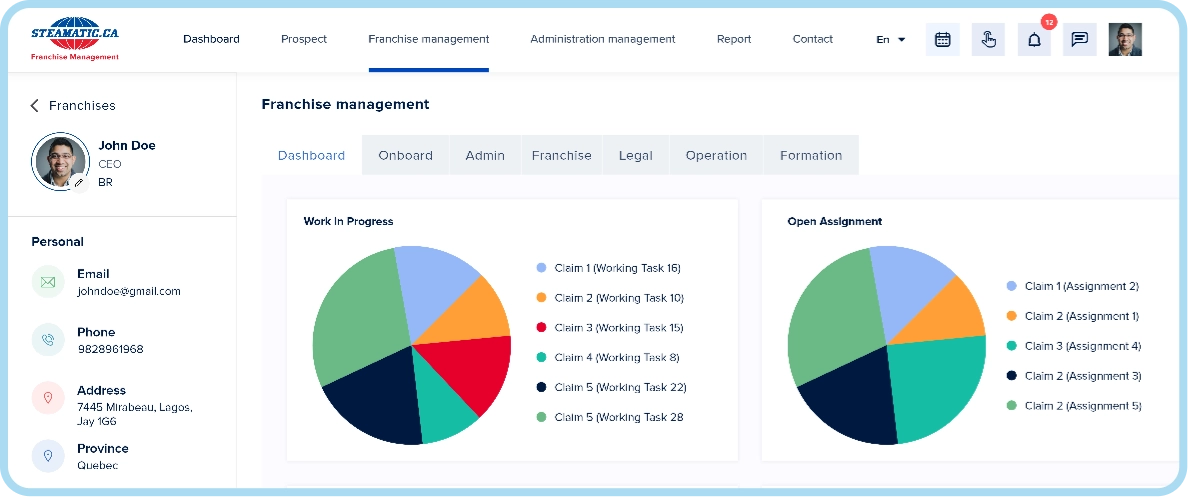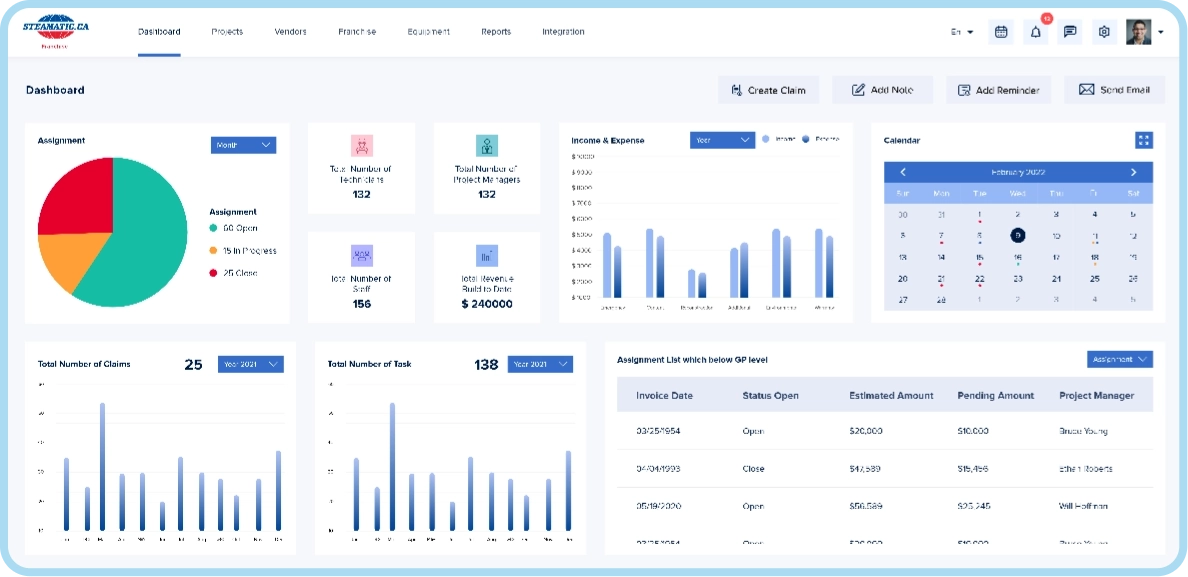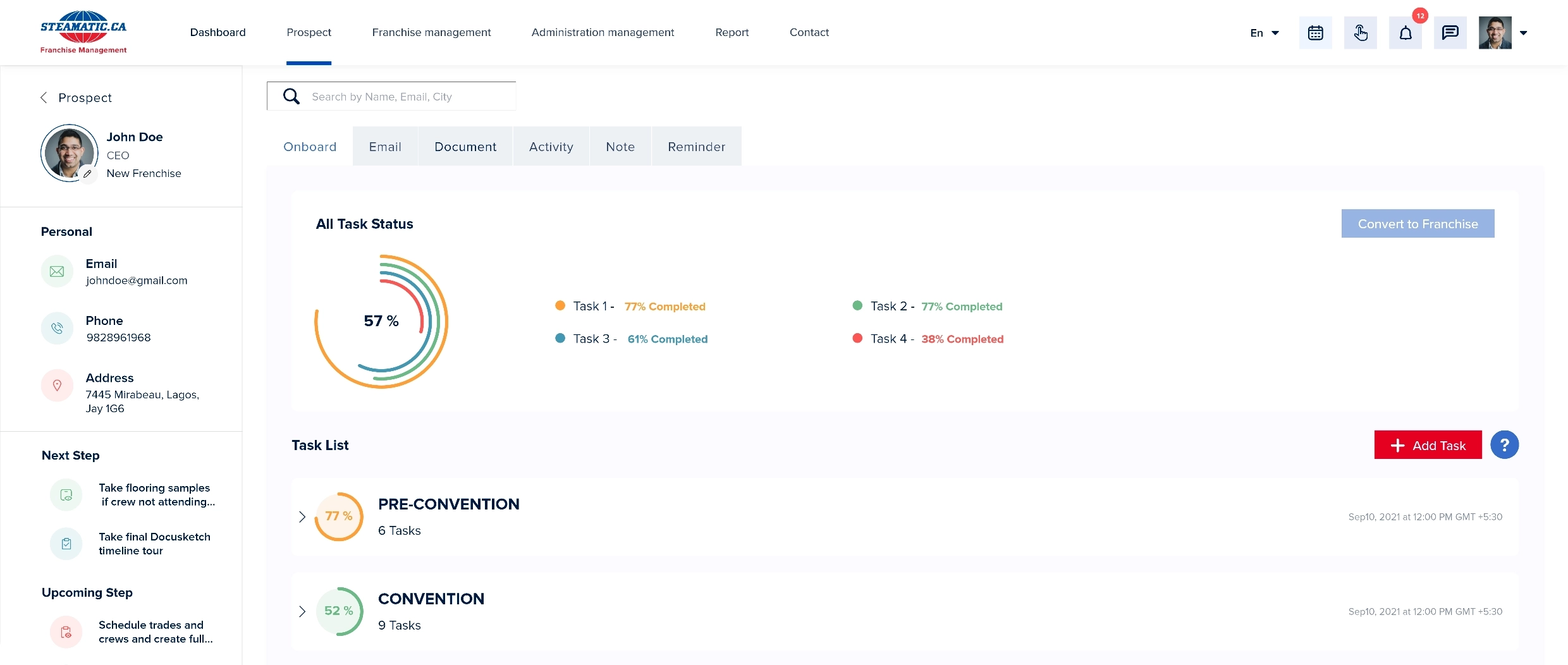DotNet Core

i

Steamatic, a leader in restoration and cleaning services, partnered with CMARIX to elevate its digital presence and streamline its workload management. With a focus on creating a robust Workload Management System (WMS), the collaboration aimed to provide a seamless experience for both Steamatic's sub-offices and their clients. The WMS, developed by CMARIX, is a comprehensive solution that handles various aspects of Steamatic's operations, from claim assignments and invoicing to financial tracking and reporting. The system is designed to be fully API-compliant and operates efficiently on both iOS and Android platforms.

DotNet Core
Web Users
Insurance
Canada
May not be suitable for small or regular transactions due to higher fees.
Navigating complex regulations from agencies like OSHA and LEED, affecting service quality and costs.
The inconvenience of dealing with multiple vendors for different services, affecting operational efficiency.
Lack of advanced technologies for efficient and effective cleaning and restoration services.
Rising customer expectations for quicker, more efficient, and eco-friendly services.
The growing demand for sustainable and eco-friendly cleaning solutions.
The industry is sensitive to economic downturns, affecting the demand for cleaning and restoration services.
The challenge of offering services across diverse locations in the U.S., each with its own set of regulations and customer expectations.
Intense competition from both established players and new entrants, affecting market share and profitability.


CMARIX kicked off the project with an in-depth requirement analysis, focusing on the unique challenges and needs of the U.S. restoration and cleaning industry.
Conducted a SWOT analysis to identify the strengths, weaknesses, opportunities, and threats in Steamatic's existing processes.
Recommended the use of DotNet Core and MS-SQL based on the project's scalability and performance needs.

Leveraged the power and flexibility of DotNet Core to develop custom features tailored to Steamatic's operational needs.
Ensured data integrity and optimized performance by using MS-SQL for database design.
Seamlessly integrated cross-application functionalities to facilitate data flow between different modules and third-party services.

Utilized cloud services to ensure the system's scalable and reliable hosting.
Implemented real-time monitoring tools to keep track of system health and performance.
Offered continuous updates, security patches, and feature enhancements to keep the system up-to-date and compliant with industry standards.


Crafted a user-centric interface aimed at enhancing both client and sub-office user engagement.
Developed a robust, scalable architecture that could accommodate various modules, including claim management and XA integrations.

Undertook rigorous testing protocols to ensure the system's reliability, security, and scalability.
Conducted periodic code reviews to maintain code quality and adhere to best practices.

Conducted training sessions for Steamatic staff to ensure effective management of the new WMS.
Supplied comprehensive documentation for future reference, updates, and maintenance.


Developed a widget-based dashboard that allows users to customize their view based on roles and responsibilities.
Integrated real-time analytics to display key performance indicators (KPIs) on the dashboard.
Implemented dynamic forms with conditional fields to capture varying types of claims.
Enabled a drag-and-drop interface for easy assignment and reassignment of claims.
Designed a multi-step approval workflow for PO requests, including dual authorization checks.
Incorporated an interactive calendar for tracking PO statuses, start dates, and completion dates.
Implemented RBAC to define different levels of access based on user roles.
Enabled SSO for a unified and secure login experience.
Incorporated Elastic Search for fast and accurate data retrieval.
Added advanced filtering options for more refined search results.
Implemented 2FA to enhance security.
Employed SSL/TLS encryption to secure data transmission.
Utilized RESTful APIs for seamless XA integrations, allowing data exchange between the WMS and third-party services.
Implemented real-time data synchronization to ensure consistency across all integrated platforms.
Integrated push notifications to alert users about new claims, approvals, and other updates.
Configured automated email notifications for specific triggers like claim assignment and PO approval.









The system is designed using a microservices architecture pattern, allowing each functional module to operate independently. This ensures scalability and makes it easier to update individual components.
An API Gateway is used as the entry point for all client requests, routing them to appropriate microservices. This adds an extra layer of security and enables load balancing.
The system uses MS-SQL as its primary database, optimized for ACID compliance and high-performance queries.
To handle large volumes of data, the database is sharded based on claim types, improving query performance and scalability.
The front-end is designed as an SPA using ReactJS, reducing page reloads and enhancing user experience.
A component-based design approach is used for UI elements, making it easier to maintain and update the front-end.
The back-end is developed using DotNet Core, offering high performance and cross-platform support.
The system exposes RESTful APIs for communication between the front-end and back-end, as well as for XA integrations.
A middleware layer is introduced to handle XA integrations, ensuring seamless data flow between different modules and third-party services.
A message queue is implemented for asynchronous processing of tasks like sending notifications and syncing data.
JSON Web Tokens (JWT) are used for secure authentication.
Firewalls are set up at both the API Gateway and individual microservices, along with rate limiting to prevent abuse.
The application is containerized using Docker, allowing for easy deployment and scaling.
The system is deployed on a cloud platform, taking advantage of auto-scaling and disaster recovery features.
A simple and intuitive interface for customers to submit claims.
Forms adapt based on the type of claim, capturing all necessary details.
Customers can track the status of their claims in real-time.
Automated notifications keep customers informed at every stage of the claim process.
Integrated secure payment options for service charges.
Customers receive digital invoices with detailed breakdowns of services rendered.
Customers can rate and review the services they received.
Customer feedback is analyzed for continuous improvement.
Define roles and permissions for different types of users within the system.
Keep track of user activities for compliance and auditing purposes.
A comprehensive dashboard displaying all claims, their statuses, and other key metrics.
Ability to approve, reject, or reassign claims in bulk.
Generate custom reports based on various parameters like claim type, region, and time period.
Advanced data visualization tools for better insights.
Set up automated alerts for specific triggers, such as a high volume of claims or payment failures.
Ability to send manual notifications to customers or internal teams.
Super Admins can configure system settings, including notification templates and payment gateway options.
Manage and configure XA integrations directly from the admin panel.
Allows the super admin to define roles and permissions for different types of users, such as project managers, technicians, and end customers.
Provides real-time analytics and KPIs to help the super admin make data-driven decisions.
Enables the tracking and management of all cleaning and restoration equipment and materials.
Automates various stages of a project, from initiation to completion, ensuring a streamlined process.
Integrated billing and invoicing system that supports multiple payment gateways.
Allows for the secure storage and retrieval of all project-related documents.
Facilitates the integration of third-party services and tools through well-documented APIs.
Implements advanced security measures, including data encryption and two-factor authentication, to protect sensitive information.
Keeps a detailed log of all activities performed in the backend, aiding in accountability and transparency.
Backend support for specialized XA integrations, enhancing the system's capabilities and functionalities.
Tools for monitoring server health, performance, and security, ensuring uninterrupted service.
Techniques for optimizing the MS-SQL database for faster query processing and better performance.
DotNet Core
IIS
Microsoft Azure
OAuth 2.0
MS-SQL:
Git
RESTful APIs
Your unique concepts will be crafted into a remarkable end result by our team.